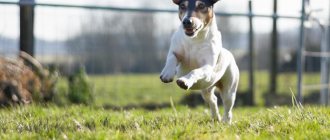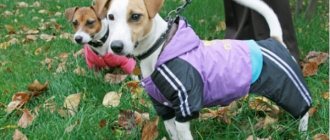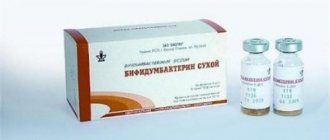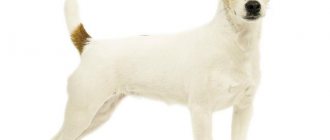The Jack Russell Terrier is originally a hunting dog breed.
She is distinguished by her instant response, activity and friendliness.
Nowadays, this dog has become an excellent companion for people who do not sit still and lead an active lifestyle.
In this article we will talk about Jack Russell puppies - how to choose them and how to care for them. We will also show you photos of these cute babies.
Brief information about the breed
Dogs of this breed were bred in Great Britain for burrowing . The breed combines small size, strength, courage and powerful jaws. All this was needed to penetrate the hole and grab prey.
NOTE!
The breed is named after the English pastor John Russell from Devonshire. He was very fond of horse hunting, and it was he who first described these dogs.
Nowadays, the Jack Russell Terrier has an average weight of 5-7 kg, and a height at the withers of 25-31 cm. The skull is slightly narrowed towards the eyes. The eyes themselves are shaped like almonds, dark and deep-set. The chest has a girth of 40-43 cm, the tail is docked. The life expectancy of dogs of this breed with proper care is on average up to 14-15 years.
From the first days, Jack Russell Terrier puppies are characterized by excessive activity and a desire to dominate their owner, therefore, in order to turn a Russell into a well-mannered dog, you will have to make a lot of effort. Raising a Jack Russell should take place without shouting and beating, but at the same time without indulging in all the dog’s pranks, which will turn the puppy into a real little devil in the future.
To prevent bad behavior, you need to stop any antics of your pet, not be touched by his pranks, and not allow the dog to become the main one in the house and manipulate you.
What breed of dog was featured in the movie "The Mask"?
Any viewer who has ever seen the comedy “The Mask” about a charming gentleman in a canary suit with a green face, probably noticed how professionally the protagonist’s dog behaves in the frame: he clings to the door handle with a death grip, flies up into the air after a flying rubber plate, and rescues his master Ipkiss from captivity, following commands. And after all, the role of Milo actually starred a dog actor named Moose, who had participated in the filming of comedy films before. But real fame came to Milo-Moose after the release of the film “The Mask”. By the way, actor Jim Carrey got so used to the terrier Moose during filming that he later got himself a pet of just this breed.
The name of the breed from the movie “The Mask” is Jack Russell Terrier, and not a mongrel, as ignorant people sometimes said about Milo. Why was preference given to the dog of this particular breed? To begin with, it should be mentioned that these small hunting dogs are very active and agile by nature. In addition, they are obedient and are not used to showing their bad mood when they have to work. Moreover, the Jack Russell Terriers look quite serious and are very cute, like grown-up puppies. So, now it’s clear which dog starred in the movie “The Mask”. What is interesting about these beautiful animals?
What do newborn puppies look like?
Puppies are born blind, their muzzle and body do not yet have the proportions of an adult dog, so it is not yet possible to judge their future appearance. This can be done much later.
The puppy's coat already has a color that will remain in the future. The tail is pressed to the body, the ears puff up. The tip of the nose and paws are pink or pinkish in color. The type of coat is not yet clear.
Jack Russell puppies are 14-16 cm in size at birth. Weight usually exceeds 200 g and ranges from 200 to 250 g.
These indicators are not universal, they depend on:
- heredity;
- the period at which the puppies were born;
- number of puppies in the litter.
Development by months
At one month the puppy already has its first teeth:
- fangs;
- incisors;
- the first and second false-root ones.
He begins to emerge from his den along with the other puppies.
This is the time when you need to start toilet training your dog. During the first month, the breeder observes an increase in the puppy’s activity and how he gets used to his name. The dog develops a daily rhythm.
IMPORTANT!
At the age of 45 days it is recommended to brand the puppy. At this time, the baby is also already accustomed to hygiene procedures - combing, cleaning the ears and examining the teeth.
The puppy continues to explore the world. Closer to the age of two months, he begins to better remember commands, chew and ruffle objects around him. He is growing and gaining weight, but at this age it is still impossible to see the puppy’s shortcomings.
Further development occurs in the following order:
- At 2-2.5 months, the puppy begins a period of fear. At this time, you need to communicate with him as much as possible and avoid things that would frighten the dog. Also at this time the puppy is already switching to food. At 2 months, the puppy begins to bark and all of his baby teeth appear. This is the right time to start accustoming him to trips and walks. The dog continues to grow and gain weight;
- from 2 to 5 months, the proportions of the dog’s head and body are determined. Character and teeth change;
- at 3 months the dog is already ready for independent life. During these three months, his individual character traits are formed;
- from 4-8 months the dog begins to want to run away from its owner. This is the time for the dog's "sexy" games. The optimal age to move to a new family. The puppy is fully formed and after changing teeth the bite is visible. At this age, the dog’s character, its preferences and habits are visible;
- at 7-8 months the dog’s growth stops;
- at 8-9 months the dog’s teeth finally change. Fangs that have not fallen out need to be pulled out;
- from 6-10 months the bitch begins her first heat and puberty begins. Males mark their territory and raise their paw;
- 6-12 months is a time of fear of new situations. A new trusting relationship is formed between the dog and the owner. During this period, you should not force the dog to approach the object that it is afraid of;
- at 12 months, the dog completes the formation of the “dominance-submission” relationship.
Types of puppies
In newborn puppies, it is not yet clear what type of coat the puppy will be. This can only be understood when the puppy reaches 3 months.
One way or another, Jack Russell Terrier dogs are divided into three types based on coat type:
- smooth-haired – the coat is close to the body, the undercoat is dense;
- long-haired or wire-haired – hard and long hair that does not adhere to the dog’s body;
- intermediate or brocken - the dog does not grow eyebrows or a beard, the length of the coat is longer than that of other types, but it is adjacent to the body, and does not bristle, like long-haired dogs.
Appearance of Jack Russell Terrier
Reverend John, when creating the breed, cared exclusively about the functionality of the dogs without paying attention to the exterior. After all the changes, by the middle of the 20th century. cynologists in America and Australia have identified two types of dogs.
More square, with long legs is called the Parson Russell Terrier (33-35 cm at the withers). The "rectangular" type dog is the Jack Russell. The confusion with names still exists. Before going to an exhibition, you should make sure which name and standards are used in a given country.
The current standards were adopted in 2012 and make tail docking optional. An important proportion is “the size of the half-circumference of the chest is approximately equal to the distance from the elbow of the front paw to the floor.”
- Muzzle. The nose and lips are black, the jaws are very strong and powerful, strong sharp teeth, correct bite (the lower jaw goes under the upper). Almond-shaped eyes, black edges. Eyes are brown. The ears are erect or hanging, but very mobile.
- Strong neck. Muscular body of correct proportions. The host does not have to be docked; it should be raised up when moving.
- The coat can be smooth or hard - it doesn’t matter, the main thing is that it should protect the dog from bad weather. The predominant color is white; it can have spots of any shade from light yellow to dark brown.
- Dimensions. Height at the withers is from 25 to 30 cm. Weight should be proportional to height: with a height of 25 cm - approximately 5 kg, with a height of 30 cm - 6 kg.
Behavioral characteristics are very important for Russell Terriers. Aggressive or, on the contrary, very shy and cowardly dogs are disqualified.
Features of care
Before the puppy comes into your home, prepare the space - remove small objects and wires, as well as other things that could harm the baby, from visible places. Remove personal and expensive items that could be damaged.
Prepare a place for the puppy. There should be no drafts, windows, or heating objects near it. Try to make it a place where the dog is at peace. If you need to isolate your baby for a while, use a playpen, cage or enclosure.
As soon as the puppy appears in the house, show him who is the boss. Designate an area where he can play, sleep, eat, and where he should stay away. It is better not to retreat from such tactics. Raise your puppy from the first days, while he is still trainable.
There should always be toys in the Jack Russell's personal place that will distract him while you are busy with your business or while you are relaxing.
Train him to toilet in a timely manner - usually after sleep or after eating. Buy a special diaper at a pet store. As soon as you notice the puppy’s anxiety, show him a place to relieve himself.
After the required vaccinations, you can accustom the puppy to the street. To do this, use an already used diaper - the dog will react to the smell.
The first walks should be no more than 10 minutes. As the puppy grows, increase the time. Even if the weather is bad outside, be sure to take the puppy out, at least so that he can go to the toilet.
Don't forget to play active games with your puppy during walks. Stop your puppy from chasing other dogs and cats. Teach him discipline.
Brush your puppy several times a week. During molting season - daily. Puppies with long hair will have to be taken to a grooming salon. Teach your baby to behave calmly during hygiene procedures.
NOTE!
Don't forget to clean your puppy's ears and trim his nails. If necessary, rub your eyes. To care for your teeth, purchase a special brush from a pet store.
You can bathe the puppy after scheduled vaccinations, when two weeks have passed. This breed does not need to be washed frequently, but only with special shampoos. On average, Russells are bathed three times a year.
Read about other features of Jack Russell care here.
What should the diet be like?
In the first few weeks that you have a puppy, you should feed it the same as the breeder fed it, gradually transitioning it to the desired diet .
If you plan to feed your Jack Russell with industrial food in the future, then choose premium or super-premium products.
If you want to feed your pet natural food, then begin to gradually introduce the following products into his diet:
- meat;
- fish;
- dairy products;
- cereals;
- vegetables and fruits;
- eggs.
For 1 kg of puppy, 20-30 g of meat per day is required.
Ideal meat choices include beef, turkey and chicken breast. Shred the beef before serving, but you will have to cook the chicken and turkey.
A couple of times a week you should give fish, but only sea or ocean fish. Before serving, boil and remove bones.
At first, small puppies should replace cow's milk with 10% cream diluted with water. Calcined cottage cheese can also be an alternative. It should be given several times a week, 30-50 g.
You can start your first complementary foods with buckwheat and rice porridges.
The Jack Russell digests carrots, beets, zucchini and pumpkin best. During the season, you can add a little greenery to them.
You can give an apple as a fruit. You can give other fruits if the puppy is interested, but you should avoid feeding citrus fruits .
Sometimes give your puppy an egg omelet, but no more than 1-2 times a week.
Features of the breed from the movie "The Mask"
Terriers like Milo were bred in Great Britain at the dawn of the 19th century. The blood of modern Jack Russells contains the blood of fox terriers, beagles, greyhounds, and corgis. In the past, the purpose of Jack Russells was considered to be burrow hunting for animals of medium and small size. Today, they are often purchased as companion dogs for active people who have enough time to walk their pets.
The appearance of these dogs is simple: 25-30 cm in height, 5-6 kg in weight, flat head tapering towards the tip of the nose, elongated body, strong neck, medium-length strong limbs. Jack Russell ears are usually droopy, but can rise at the slightest rustle. The nose of dogs is always black and of medium size. The eyes are small, almond-shaped, very intelligent. The coat is soft or coarse, the color is predominantly white, but there are markings of a black or brown-red hue (this is the color of the dog from the movie “The Mask”).
The character of Jack Russells is contradictory. On the one hand, they are very attached to their owner and do not need any other company. On the other hand, these dogs are still hunters and should not be treated as soft toys. They have a sense of self-esteem and can, for example, snap back when the owner’s child crossed the line during play (grabbed the dog by the ear and threw it in the air). In addition, Jack Russells are capable of coming into conflict with a dog whose weight exceeds a couple of tens of kilos. All such terriers are very active and love games and communication. They should never be placed in an outdoor enclosure, depriving them of participation in the life of the owner’s family and long walks.
With proper upbringing, a puppy of this breed will grow up to be a cheerful, cunning, skillful and fearless pet. If you teach a dog obedience and commands from time to time, and even more so limit the animal’s movement, the Jack Russell will grow into a real house monster, destroying furniture, wires, the owner’s shoes, and even trying to grab hold of an unwanted house guest, or even into the owner.
The rather irrepressible nature of the Jack Russell is compensated in part by trivial care: the owner will only need to comb the dog’s fur a couple of times a week with a stiff brush. Even during shedding, you won’t expect a lot of hair falling out from a Jack Russell.
The life expectancy of these small dogs is quite high - 12-16 years. Terriers can boast of good health, although some individuals sometimes experience problems with the motor system (joint dysplasia, arthritis) and vision (cataracts, glaucoma).
How to feed?
The Jack Russell should eat from a bowl on a special stand that can be adjusted as the puppy grows.
Don't feed him from the table, even if he asks. Accustom your dog to a routine - to eat in a certain place at a certain time.
If you decide to feed your puppy natural food, make sure that he receives all the necessary substances and that the diet is balanced.
CAREFULLY!
Do not give your puppy sweet, pickled, smoked, fatty or salty foods. This will lead to health problems.
Food should be at room temperature.
From 4 months, you need to feed your puppy six times a day, reducing the number of feedings every month. After 9 months, the dog should eat 2 times a day.
Make sure your dog always has fresh water at room temperature.
First vaccinations
At 21 days, the puppy and mother are dewormed. This is usually done with a suspension of Drontal Junior, Pirantel and other drugs.
At 4-6 weeks they are vaccinated against distemper and parvovirus enteritis.
At 3-9 weeks the following vaccinations are given:
- repeatedly from plague and parvovirus enteritis;
- from hepatitis;
- from parainfluenza;
- from leptospirosis.
At 12 weeks, revaccination against distemper, hepatitis, parvovirus enteritis, and leptospirosis is carried out. Vaccination against rabies is carried out.
At 6-8 months after changing teeth, revaccination against distemper, hepatitis, parvovirus enteritis and leptospirosis is carried out.
Price range
How much does a Jack Russell puppy cost?
The highest price for a dog is set when the dog is 5-6 months old. The lowest price is for a puppy one and a half months old.
This is explained by the fact that both its advantages and disadvantages are already visible in a grown-up puppy. If you take a baby, you are literally playing the lottery.
Based on this information, the standard price range for a Jack Russell Terrier puppy ranges from 20 to 40 thousand rubles, taking into account pedigree and vaccinations and provided that you take the puppy from an experienced breeder.
If this information is not important to you, then in this case the price for a Jack Russell starts at 10 thousand rubles.
History of the Jack Russell Terrier breed
Arthur Heinemann continued the pastor's work after his death in 1883. Heinemann headed the club and wrote the breed standard in 1904. The description of the Jack Russell Terrier includes a lot of information about the behavior and habits of the dogs, and little is said about the appearance. It is believed that Heinemann actively worked with bull and terriers to make the dog stronger for hunting badgers. He introduced the practice of docking the tail by ⅓ to make it easier to pull the dog out of the hole without damaging the tail.
By the beginning of the 20th century. Short-legged terriers came into fashion, this was explained by changes in hunting conditions - now the hunter walked, the terrier, due to its shorter legs, moved more slowly, but dealt cruelly with the fox and badger. This is how the breed was divided into Parson Russell Terriers and Jack Russell Terriers. The worldwide popularity of the breed was promoted by the 1994 film “The Mask,” in which the Jack Russell terrier can be considered a full-fledged character. This breed appeared in Russia in 1999 from the USA.
How to choose a puppy?
As with many breeds, the Jack Russell has certain standards that you need to familiarize yourself with so as not to be deceived.
You also need to pay attention to the following:
- the puppy should be active and mobile, look cheerful. Avoid shy and indifferent dogs;
- length and height should be proportional. The puppy's structure should be proportional;
- According to the standard, the dog's head should be of medium width and taper towards the eyes and ears. The nose should be black, the eyes should be black almond-shaped, and the jaw should be strong. The ears should be V-shaped and close-fitting;
- check the dog's appearance and proportions. Are there any external defects? The puppy must have an athletic appearance;
- from the rear, even a puppy should look strong and muscular. The tail should be set high. A healthy puppy always wags him happily;
- pay attention to the wool. If the puppy is smooth-haired, check for fine spots. A long-haired puppy or brocken should not look fluffy. 51% or more of the color must be white. Acceptable colors are red, black and brown shades;
- The puppy's gait should be lively and even.
Who would like the dog from the movie “The Mask”?
Despite the cute appearance of dogs like Milo from The Mask, some people should not have dogs of this breed. Before purchasing an animal, you should consider the following facts:
- “Small” Jack Russells require the same active walking as large dogs. Keeping an animal within four walls all the time will not work;
- If there are other dogs in the house with a difficult dominant character, the Jack Russell may easily not get along with them. In addition, Jack Russells are quite jealous, which is why they can have clashes with other pets;
- Jack Russells are hunters, so even without training they will catch cats and rodents if they are not weaned from this from an early age. If there is, say, a guinea pig in the house, the dog must be taught from the first days of being in the house that it is forbidden to touch the rodent;
- A priori, such a dog should not be owned by very elderly, lazy or busy people who will not be able to provide the dog with proper physical activity;
- These dogs love to bark loudly if something has alerted or angered them (hunting instincts come into play again), so they may not be suitable for people who love silence;
- Female Jack Russells are usually calmer and more affectionate than male Jack Russells of the same breed. Males are usually hyperactive and very fearless;
- Jack Russell dogs (if they are well trained) are able to stand up not only for themselves, but also for their owners. Of course, they will not be able to cause serious harm due to their modest size, but they are quite capable of driving away a dog that has stuck to its owner;
- It is best if the owner of the Jack Russell has character, that is, moderately strict, but fair. Connivance, excessive pity and lack of education will turn the puppy into an uncontrollable adult, which, thanks to its irrepressible energy, will behave disgustingly.











